Papers by Patrick Musonda
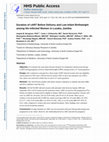
Journal of acquired immune deficiency syndromes (1999), Jan 30, 2015
To estimate the association between duration of combination antiretroviral therapy (cART) during ... more To estimate the association between duration of combination antiretroviral therapy (cART) during pregnancy and low infant birthweight (LBW), among women >37 weeks gestation. We conducted a retrospective cohort study of HIV-infected women who met eligibility criteria based on CD4 count ≤350 but had not started cART at entry into antenatal care (ANC). Our cohort was restricted to births that occurred >37 weeks gestation. We used Poisson models with robust variance estimators to estimate risk ratios (RR) and 95% confidence intervals (CI). Of 50,765 HIV-infected women with antenatal visits between January 2009 and September 2013, 4,474 women met the inclusion criteria. LBW occurred in 302 pregnancies (7%). Nearly two-thirds of women (62%) eligible to initiate cART never started treatment. Overall, 14% were on cART for ≤8 weeks, 22% for 9-20 weeks, and 2% for 21-36 weeks. There was no evidence of an increased risk of LBW for women receiving cART for <8 weeks (RR 1.22, 95% CI: 0....
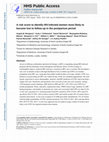
AIDS care, Aug 17, 2016
Access to lifelong combination antiretroviral therapy (cART) is expanding among HIV-infected preg... more Access to lifelong combination antiretroviral therapy (cART) is expanding among HIV-infected pregnant and breastfeeding women throughout sub-Saharan Africa (SSA). For this strategy to meaningfully improve maternal HIV outcomes, retention in HIV care is essential. We developed a risk score to identify women with high likelihood of loss to follow-up (LTFU) at 6 months postpartum from HIV care, using data from public health facilities in Lusaka, Zambia. LTFU was defined as not presenting for HIV care within 60 days of the last scheduled appointment. We used logistic regression to assess demographic, obstetric and HIV predictors of LTFU and to develop a simple risk score. Sensitivity and specificity were assessed at each risk score cut-point. Among 2029 pregnant women initiating cART between 2009 and 2011, 507 (25%) were LTFU by 6 months postpartum. Parity, education, employment status, WHO clinical stage, duration of cART during pregnancy and number of antenatal care visits were associ...
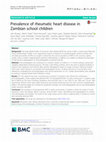
BMC cardiovascular disorders, Jan 3, 2018
The large global burden of rheumatic heart disease (RHD) has come to light in recent years follow... more The large global burden of rheumatic heart disease (RHD) has come to light in recent years following robust epidemiologic studies. As an operational research component of a broad program aimed at primary and secondary prevention of RHD, we sought to determine the current prevalence of RHD in the country's capital, Lusaka, using a modern imaging-based screening methodology. In addition, we wished to evaluate the practicality of training local radiographers in echocardiography screening methods. Echocardiography was conducted on a random sample of students in 15 schools utilizing a previously validated, abbreviated screening protocol. Through a task-shifting scheme, and in the spirit of capacity-building to enhance local diagnostic and research skills, general radiographers based at Lusaka University Teaching Hospital (UTH) were newly trained to use portable echocardiography devices. Students deemed as screen-positive were referred for comprehensive echocardiography and clinical e...
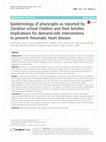
BMC infectious diseases, Jul 6, 2017
Prompt and appropriate treatment of streptococcal pharyngitis decreases the risk of acute rheumat... more Prompt and appropriate treatment of streptococcal pharyngitis decreases the risk of acute rheumatic fever and rheumatic heart disease (RHD). Understanding public perceptions and behaviors related to sore throat is fundamental to inform health programs aimed at eliminating new cases of RHD in endemic regions. We sought to describe the epidemiology of pediatric pharyngitis and its treatment, as reported by children and their parents or guardians in Lusaka, Zambia. This was a cross-sectional investigation using interviews and written surveys, nested in a school-based RHD prevalence study. Students and their parents were asked to report number of sore throats in the previous 12 months, treatment received, and type and place of treatment. A focused history and physical examination to detect pharyngitis was conducted and children were referred for follow-up as indicated. A total of 3462 students from 47 schools participated in the study, along with their parents or guardians. Six hundred ...
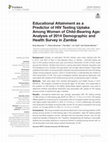
Frontiers in public health, 2018
Globally, an estimated 150,000 children were newly infected with HIV in 2015, over 90% of them in... more Globally, an estimated 150,000 children were newly infected with HIV in 2015, over 90% of them in Sub-Saharan Africa. In Zambia, ~500,000 babies are born to HIV positive mothers every year, and without intervention 40,000 of them would acquire the infection. Studies have shown a strong association between education and HIV prevalence, but in Zambia, this association has not been demonstrated. There is little published information on the association between educational attainment and HIV testing uptake among pregnant women, which is fundamental in understanding the mother to child transmission of HIV. This study investigated whether educational attainment was associated with uptake of HIV testing among women of reproductive age in Zambia. Data were taken from Zambia Demographic and Health Survey in 2014 (ZDHS14). The analysis consisted of all women aged 15-49 years, who responded to the question on HIV testing in the ZDHS. Multivariable logistic regression was used to determine wheth...
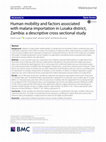
Malaria Journal, 2018
Background: Malaria is a major public health problem in Zambia with an estimated 4 million confir... more Background: Malaria is a major public health problem in Zambia with an estimated 4 million confirmed cases and 2389 deaths reported in 2015. Efforts to reduce the incidence of malaria are often undermined by a number of factors such as human mobility which may lead to introduction of imported infections. The aim of this study was to establish the burden of malaria attributed to human mobility in Lusaka district and identify factors associated with malaria importation among residents of Lusaka district. Methods: A cross sectional study was conducted in five randomly selected health facilities in Lusaka district from November 2015 to February 2016. Data was collected from 260 patients who presented with malaria and whose status was confirmed by rapid diagnostic test or microscopy. Each confirmed malaria case was interviewed using a structured questionnaire to establish their demographic characteristics, travel history and preventive measures. Travel history was used as a proxy to classify cases as either imported or local. Residency was also used as a secondary proxy for importation to compare characteristics of residents vs non-residents in relation to malaria importation. Logistic regression was used to determine factors associated with malaria importation among residents of Lusaka district. Results: Out of 260 cases, 94.2% were classified as imported cases based on participants' travel history. There were 131 (50.4%) males and 129 (49.6%) females. Age distribution ranged from 0 to 68 years with a median age of 15 years (IQR 8-27). Imported cases came from all the ten provinces of Zambia with the Copperbelt Province being the highest contributor (41%). Of all imported cases, use of prophylaxis was found to be highly protective [AOR = 0.22 (95% CI 0.06-0.82); p-value = 0.024]. Other factors that significantly influence malaria transmission and importation by residents include duration of stay in a highly endemic region [AOR = 1.25 (95% CI 1.09-1.44); p-value = 0.001] and frequency of travel [AOR = 3.71 (95% CI 1.26-10.84); p-value = 0.017]. Conclusion: Human mobility has influenced malaria transmission in Lusaka district through a number of factors by importing infections. This leads to onward transmission and poses a challenge to malaria elimination and control. However, taking of prophylaxis is highly protective and must be highly recommended.
Archives of Public Health, 2018
Background: Mother to child transmission of HIV (MTCT) still remains a challenge affecting many c... more Background: Mother to child transmission of HIV (MTCT) still remains a challenge affecting many countries. Globally, an estimated 150,000 children were newly infected with HIV in 2015, over 90% of them in Sub-Saharan Africa through MTCT. In Zambia approximately 500,000 babies are born and 40,000 acquire the infection vertically if there is no intervention annually. This study estimated the HIV testing coverage and associated factors among Zambian women of reproductive age 15-49 years.
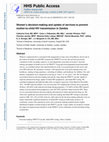
AIDS care, Jan 3, 2017
Women's empowerment is associated with engagement in some areas of healthcare, but its role i... more Women's empowerment is associated with engagement in some areas of healthcare, but its role in prevention of mother-to-child HIV transmission (PMTCT) services has not been previously considered. In this secondary analysis, we investigated the association of women's decision-making and uptake of health services for PMTCT. Using data from population-based household surveys, we included women who reported delivery in the 2-year period prior to the survey and were HIV-infected. We measured a woman's self-reported role in decision-making in her own healthcare, making of large purchases, schooling of children, and healthcare for children. For each domain, respondents were categorized as having an "active" or "no active" role. We investigated associations between decision-making and specific steps along the PMTCT cascade: uptake of maternal antiretroviral drugs, uptake of infant HIV prophylaxis, and infant HIV testing. We calculated unadjusted and adjusted o...
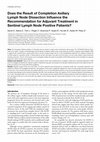
Clinical Breast Cancer, 2013
Aims: The Hungarian National Institute of Oncology has just closed a single-centre randomized cli... more Aims: The Hungarian National Institute of Oncology has just closed a single-centre randomized clinical study. The OTOASOR (Optimal Treatment of the Axilla-Surgery or Radiotherapy) trial compares completion axillary lymph node dissection (ALND) to regional nodal irradiation (RNI) in patients with sentinel lymph node-positive (SLN+) primary invasive breast cancer. In the investigational treatment arm patients received 50 Gy RNI instead of completion ALND. In these patients we had information only about the SLN status, but the further axillary nodal involvement remained unknown. The aim of this study was to investigate whether the result of completion ALND influenced the recommendation for adjuvant treatment in SLN+ breast cancer patients. Patients and methods: Patients with SLN+ primary breast cancer were randomized for completion ALND (arm A-standard treatment) or RNI (arm B-investigational treatment). Adjuvant systemic treatments was given according to the standard institutional protocol and patients were followed according to the actual institutional guidelines. Results: Between August 2002 and June 2009, 474 SLN+ patients were randomized to completion ALND (arm A-standard treatment, 244 patients) or RNI (arm B-investigational treatment, 230 patients). There were no significant differences in terms of major prognostic factors between the two arms. Two-hundred and fourty-two patients (99.6%) on arm A and 229 patients (99.6%) on arm B received adjuvant systemic treatments including chemotherapy and/or endocrine treatment (p=NS). One-hundred and ninety-four patients (79.5%) received adjuvant chemotherapy on arm A and 159 patients (69.1%) on arm B (p=0.031). Two-hundred and four patients (83.6%) received adjuvant endocrine treatment on arm A and 196 patients (85.2%) on arm B (p=NS). Six patients (2.5%) received adjuvant trastuzumab treatment on arm A and 13 patients (5.7%) on arm B (p=NS). Conclusions: The result of completion ALND after positive SLNB appears to have no major impact on the administration of adjuvant systemic therapy.

Archives of Gerontology and Geriatrics, 2014
The use of prescription drugs in older people is high and many commonly prescribed drugs have ant... more The use of prescription drugs in older people is high and many commonly prescribed drugs have anticholinergic effects. We examined the relationship between ACB on mortality and in-patient length of stay in the oldest old hospitalised population. This was a retrospective analysis of prospective audit using hospital audit data from acute medical admissions in three hospitals in England and Scotland. Baseline use of possible or definite anticholinergics was determined according to the Anticholinergic Cognitive Burden Scale. The main outcome measures were decline in-hospital mortality, early in-hospital mortality at 3- and 7-days and in-patient length of stay. A total of 419 patients (including 65 patients with known dementia) were included [median age=92.9, inter-quartile range (IQR) 91.4-95.1 years]. 256 (61.1%) were taking anticholinergic medications. Younger age, greater number of pre-morbid conditions, ischemic heart disease, number of medications, higher urea and creatinine levels were significantly associated with higher total ACB burden on univariate regression analysis. There were no significant differences observed in terms of in-patient mortality, in-patient hospital mortality within 3- and 7-days and likelihood of prolonged length of hospital stay between ACB categories. Compared to those without cardiovascular disease, patients with cardiovascular disease showed similar outcome regardless of ACB load (either =0 or &amp;amp;amp;amp;amp;amp;amp;amp;amp;amp;amp;amp;amp;amp;amp;amp;amp;amp;amp;amp;amp;amp;amp;amp;amp;amp;amp;amp;amp;amp;amp;amp;amp;amp;amp;amp;amp;amp;amp;amp;amp;amp;amp;amp;amp;amp;amp;amp;amp;amp;amp;amp;amp;amp;amp;amp;amp;amp;amp;amp;amp;amp;amp;amp;amp;amp;amp;amp;amp;amp;amp;amp;amp;amp;amp;amp;amp;amp;amp;amp;amp;amp;amp;amp;amp;amp;amp;amp;amp;amp;amp;amp;amp;amp;amp;amp;amp;amp;amp;amp;amp;amp;amp;amp;amp;amp;amp;amp;amp;amp;amp;amp;amp;amp;amp;amp;amp;amp;amp;amp;amp;amp;amp;amp;amp;amp;amp;amp;amp;amp;amp;amp;amp;amp;amp;amp;amp;amp;amp;amp;amp;amp;amp;amp;amp;amp;amp;amp;amp;amp;amp;amp;amp;amp;amp;amp;amp;amp;amp;amp;amp;amp;gt;0 ACB). We found no association between ACB and early (within 3- and 7-days) and in-patient mortality and hospital length of stay outcomes in this cohort of oldest old in the acute medical admission setting.
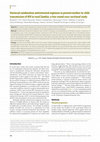
Bulletin of the World Health Organization, 2014
treatment adherence and programme retention may be poor among HIV-infected pregnant and breastfee... more treatment adherence and programme retention may be poor among HIV-infected pregnant and breastfeeding women. 12-14 Research on the implementation of antiretroviral programmes for PMTCT is needed to extend our understanding of the efficacy of these interventions in individuals to their effectiveness in the general population. 15,16 This broader understanding is urgently needed by policy-makers and programme managers who are planning to adopt or optimize maternal combination antiretroviral regimens for PMTCT in various settings. 6,17,18 The aim of this study was to evaluate, at the population level, a pilot PMTCT programme similar to Option B in rural Zambia (Table 1). Cross-sectional household surveys were performed before and after implementation of the programme to determine whether early childhood survival in the community changed during this time. Methods The pilot programme In April 2009, we implemented a pilot PMTCT programme at four health-care facilities in the rural Kafue district of Zambia using a phased approach. With support from the Zambian Ministry of Health, we offered standard combination antiretroviral regimens to all HIV-infected pregnant women, Objective To evaluate if a pilot programme to prevent mother-to-child transmission (PMTCT) of the human immunodeficiency virus (HIV) was associated with changes in early childhood survival at the population level in rural Zambia. Methods Combination antiretroviral regimens were offered to pregnant and breastfeeding, HIV-infected women, irrespective of immunological status, at four rural health facilities. Twenty-four-month HIV-free survival among children born to HIV-infected mothers was determined before and after PMTCT programme implementation using community surveys. Households were randomly selected and women who had given birth in the previous 24 months were asked to participate. Mothers were tested for HIV antibodies and children born to HIV-infected mothers were tested for viral deoxyribonucleic acid. Multivariable models were used to determine factors associated with child HIV infection or death. Findings In the first survey (2008-2009), 335 of 1778 women (18.8%) tested positive for HIV. In the second (2011), 390 of 2386 (16.3%) tested positive. The 24-month HIV-free survival in HIV-exposed children was 0.66 (95% confidence interval, CI: 0.63-0.76) in the first survey and 0.89 (95% CI: 0.83-0.94) in the second. Combination antiretroviral regimen use was associated with a lower risk of HIV infection or death in children (adjusted hazard ratio: 0.33, 95% CI: 0.15-0.73). Maternal knowledge of HIV status, use of HIV tests and use of combination regimens during pregnancy increased between the surveys. Conclusion The PMTCT programme was associated with an increased HIV-free survival in children born to HIV-infected mothers. Maternal utilization of HIV testing and treatment in the community also increased.
Scandinavian Journal of Psychology, 2010
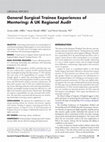
Journal of Surgical Education, 2010
OBJECTIVE: Mentoring is advocated as an essential adjunct in work-based learning providing suppor... more OBJECTIVE: Mentoring is advocated as an essential adjunct in work-based learning providing support in career and noncareer related issues. This study aims to investigate trainee experiences and satisfaction with mentoring arrangements. DESIGN: E-mail survey of surgical trainees from the East of England Higher Surgical Training Deanery, UK. MAIN OUTCOME MEASURES: Factors affecting presence of a mentoring relationship and satisfaction with mentoring arrangements were analyzed. RESULTS: Of all respondents, 62.85% stated that they were not sure or did not have a mentor; 34.29% said that they had had a meaningful meeting with their mentor; 57.14% said that they were aware of the responsibilities of a mentor; 34.29% strongly agreed or agreed that mentoring had been useful; 25.71% said that mentoring had been useful in career development; and 20% found it useful in noncareer related issues. Of those with a mentor, only 31.43% were satisfied with mentoring. Factors affecting satisfaction with mentoring included having had a meaningful meeting, having clear objectives set, and help in job transition and noncareer related issues. Knowledge of a mentor's responsibilities was also associated with satisfaction. The only factor associated with the presence of a mentoring relationship was having a mentor appointed. CONCLUSIONS: We advocate the establishment of a mentoring matching scheme for mentors and mentees together with mentor training to improve mentoring provision for surgical trainees.
JAIDS Journal of Acquired Immune Deficiency Syndromes, 2013
FIGURE. 1Adjusted hazard ratios and 95% CI for factors associated with LTFU, according to differe... more FIGURE. 1Adjusted hazard ratios and 95% CI for factors associated with LTFU, according to different definitions. BMI (in kilograms per square meter), HGB, hemoglobin (in grams per deciliter); CD4, CD4+ cell count (in cells per microliter); TB, tuberculosis.
International Journal of Epidemiology, 2012
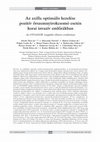
Orvosi Hetilap, 2013
Introduction: Sentinel lymph node biopsy alone has become an acceptable alternative to elective a... more Introduction: Sentinel lymph node biopsy alone has become an acceptable alternative to elective axillary lymph node dissection in patients with clinically node-negative early-stage breast cancer. Approximately 70 percent of the patients undergoing breast surgery develop side effects caused by the axillary lymph node dissection (axillary pain, shoulder stiffness, lymphedema and paresthesias). Aim: The current standard treatment is to perform completion axillary lymph node dissection in patients with positive sentinel lymph node biopsy. However, randomized clinical trials of axillary dissection versus axillary irradiation failed to show survival differences between the two types of axillary treatment. The National Institute of Oncology, Budapest conducted a single centre randomized clinical study. The OTOASOR (Optimal Treatment of the Axilla – Surgery or Radiotherapy) trial compares completion axillary lymph node dissection to axillary nodal irradiation in patients with sentinel lymph...

Foot & Ankle International, 2009
Background: A number of non-operative interventions are used to manage Achilles tendinopathy. In ... more Background: A number of non-operative interventions are used to manage Achilles tendinopathy. In particular, local glucocorticoid injections have generated controversy. Although a number of case reports indicate symptomatic relief following glucocorticoid injection, one systematic review found little evidence to support their efficacy. Furthermore, local glucocorticoid injections may be associated with rupture of the Achilles tendon. This systematic review considered all available clinical trials measuring the effect of local glucocorticoid injections on symptom relief in patients with Achilles tendinopathy. Materials and Methods: The search strategy encompassed five databases: Medline, EMBASE, CINAHL, AMED and the Cochrane Library. Only studies reporting the outcome of glucocorticoid injection for Achilles tendinopathy were included. Results: A total of 72 articles were identified, five of which met the inclusion criteria. These included one randomized controlled trial, three retro...
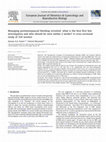
European Journal of Obstetrics & Gynecology and Reproductive Biology, 2010
The prevalence of endometrial cancer in women with postmenopausal bleeding (PMB) ranged in variou... more The prevalence of endometrial cancer in women with postmenopausal bleeding (PMB) ranged in various studies from 3% to 10%, and 95% of women with endometrial cancer present with PMB as the only complaint [1,2]. Therefore, the crucial purpose of the investigation is to rule out malignancy. In recent years, there is a trend to adopt less invasive procedures without compromising efficacy and safety [3]. While some investigators have recommended that hysteroscopy should be principal method of investigating women with PMB [4-6], several studies have demonstrated that management strategies using trans-vaginal ultrasound scanning (TVS) with or without endometrial biopsy (EB), as an initial tool of investigation, were safe [7] and more cost-effective [1,8]. TVS was suggested as a first-step procedure in evaluating women with PMB [9,10] since it can reliably assess endometrial thickness (ET) and uterine cavity morphology [11]. It is a safe, rapid, highly effective, generally painless, and relatively less invasive method. Further, it may evaluate other pelvic organs for potential abnormalities [7]. The Society of Radiologists in Ultrasound in the United States recommended-in a Consensus Conference Statement-that either TVS or EB could be used safely and effectively as the first diagnostic step in PMB. Similar sensitivities for detecting endometrial cancer were reported for TVS when an ET of 5 mm is considered as normal and for EB when sufficient tissue is obtained [12]. The Referral Guidelines For Suspected Cancer of the UK Department of Health (DoH) recommended urgent referral (within 2 weeks) for women with more than one or a single heavy episode of PMB and in women aged >55 years who are not on HRT, and early referral (within 4-6 weeks) for any other woman with PMB not on HRT [13]. Nonetheless, the UK National Institute for Health and Clinical Excellence (NICE) guidelines recommended urgent referral for all women with PMB who are not taking HRT, those

European Journal of Obstetrics & Gynecology and Reproductive Biology, 2010
There is lack of consensus amongst professional organizations as regards the cut-off age for endo... more There is lack of consensus amongst professional organizations as regards the cut-off age for endometrial sampling of premenopausal women presenting with abnormal uterine bleeding (AUB) to exclude endometrial hyperplasia or carcinoma. Therefore we conducted this study to quantify the prevalence of hyperplasia and carcinoma in different age categories in premenopausal women with AUB to identify the appropriate cut-off age for endometrial sampling. A retrospective review of the histopathology reports of endometrial samples taken from 3006 women presenting with AUB and aged from &amp;amp;amp;amp;amp;amp;amp;amp;amp;amp;amp;amp;amp;amp;amp;amp;amp;amp;gt; or =30 to &amp;amp;amp;amp;amp;amp;amp;amp;amp;amp;amp;amp;amp;amp;amp;amp;amp;amp;lt; or =50 years at Ipswich Hospital, UK, from 1 January 1998 to 31 December 2007. Women were divided into three subgroups according to age; group 1: 30 to &amp;amp;amp;amp;amp;amp;amp;amp;amp;amp;amp;amp;amp;amp;amp;amp;amp;amp;lt; or =40 (n=862), group 2: 40 to &amp;amp;amp;amp;amp;amp;amp;amp;amp;amp;amp;amp;amp;amp;amp;amp;amp;amp;lt; or =45 (n=1035) and group 3: 45 to &amp;amp;amp;amp;amp;amp;amp;amp;amp;amp;amp;amp;amp;amp;amp;amp;amp;amp;lt; or =50 (n=1109). Logistic regression revealed that the prevalence of atypical hyperplasia (OR: 3.85; 95% CI: 1.75, 8.49; p=0.01) and carcinoma (OR: 4.03; 95% CI: 1.54, 10.5; p=0.04) was significantly higher in women in group 3 when compared to younger women. There was no statistically significant difference as regards simple and complex hyperplasia in the different age categories. All but one of the women (n=23) who had complex atypical hyperplasia or carcinoma under the age of 45 years, presented with irregular rather than cyclical heavy menstrual bleeding. Our study, the largest in the literature, suggests using the age 45 years as a cut-off for sampling the endometrium in all women with AUB. However, irregular menstrual bleeding justifies investigating women regardless of their age.








Uploads
Papers by Patrick Musonda